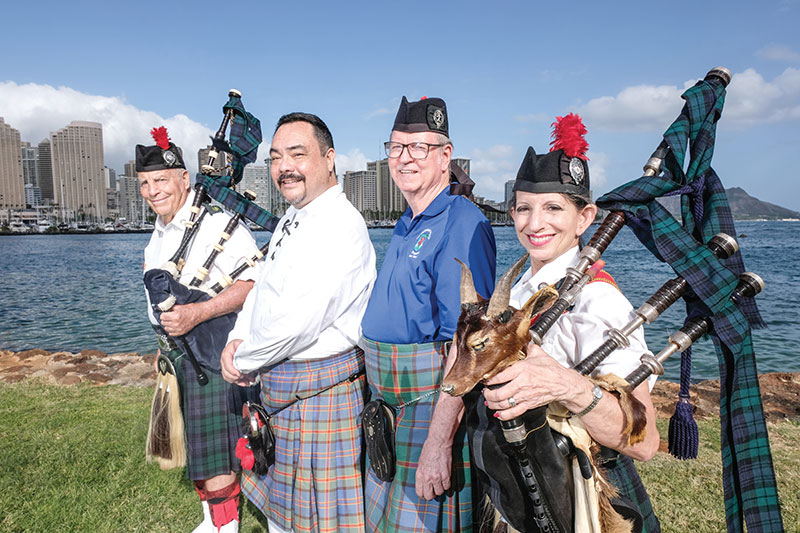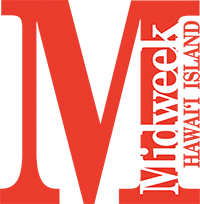It’s high time for bagpipes and games

(From left) Dressed in their tartans and ready to celebrate are Hawaiian Scottish Association secretary Hardy Spoehr, chieftain Jeremy McOuat, vice-chieftain Bruce McEwan and treasurer Tina Yap. Photo by Lawrence Tabudlo
Each April, the skirl of bagpipes, the thumps and grunts of athletic competition, and the joyous rhythms of jigs, reels and strathspeys are heard in Honolulu. These springtime sounds belong to a revelry birthed in a distant land but proudly grown and nurtured right here in the islands.
The annual spectacle known as Hawaiian Scottish Festival & Highland Games is steeped in rich Scottish and Celtic traditions. It’s an occasion when tartan-sporting clans from near and far gather for Olympic-style games, dance competitions, inspiring music, demonstrations of swordplay and more than a wee bit of good food, like Scotch eggs and canned haggis.
This year’s showcase is scheduled for 9 a.m.-4 p.m. on Saturday, April 6, and Sunday, April 7, at President Thomas Jefferson Elementary School in Waikīkī, with opening ceremonies slated for noon on both days.
The event typically draws around 2,000 attendees, of which there are a couple of dozen laddies and lassies who sign up to test their brawn in feats of strength. Most people, however, come simply to learn about their heritage and enjoy the sights and sounds of a celebration that dates back some 1,000 years to the land of Caledonia.
“Obviously, the music, the dance and the athletics are a good draw,” says Bruce McEwan, vice-chieftain of Hawaiian Scottish Association, the event’s host, and chieftain of one of its nonprofits, The Caledonian Society of Hawai‘i.
“But people are really interested in talking to those who actually have Scottish heritage. We usually get questions like, ‘What clan do I belong to?’ and ‘What would my tartan be?’”
Jeremy McOuat, chieftain of Hawaiian Scottish Association, encourages attendees to wear a kilt, if they have one, and revel in the weekend commemoration of Scottish Highland games, activities and history while understanding their connection to it all.
“I think people enjoy learning that, ‘Hey, I’ve got some Scottish heritage,’ or ‘Look, I have a clan, a tartan and a history that goes back hundreds of years,’” he says. “There’s a lot of pride in that and it’s very heartening to watch people discover their roots and share in the pride that we Scots feel.”
Something new to this year’s festivities is the presence of a seanchaí, a sort of Gaelic storyteller or “clan historian,” to help people with their genealogical searches.
“Within the seanchaí tent, we’re going to have not only Scottish history but also some Hawaiian history, and the Royal Guards of ‘Iolani Palace will also be giving a demonstration (comparing Makahiki games and Hawaiian culture with Scottish games) there as well,” notes McOuat. “So, a lot of great things are due this year and we’re excited about what we’re showcasing.”
Of course, much of the enthusiasm surrounds the always competitive Highland games, which feature traditional sporting events such as the caber toss, in which competitors must carry a nearly 20-foot-long pine or fir tree upright before flipping the pole 180 degrees and hoping that it lands both flat on the ground and, relative to the athlete, in a 12 o’clock position; the hammer throw, which requires participants to hurl steel balls attached to the end of a 4-foot-long shaft; the stone put, which is similar to track and field’s shot put event; and several weight-tossing disciplines, including the Sheaf Toss and The Widowmaker.
“Most of these events are what you would see in Olympic games or in high school or college athletic events, but it’s the caber toss that really draws most people’s attention,” explains McEwan, adding that the competition attracts both men and women who are mostly “amateur competitors, although we do get the occasional professional.”
Winners are selected in the various disciplines with an overall champion declared at the end of the competition. This year’s athletic games will be different from previous competitions, however, because results will be recorded by the official governing body, Traditional Highland Games, in Scotland.
“This is the first year with us as a sanctioned body and contestants will know that whatever they do will be a personal best record and be recorded by The Royal Scottish Highland Games Association,” McOuat says. “So everything this year is so much more meaningful.”
The first Scots in Hawai‘i were Capt. James Cook and William Anderson, a surgeon and naturalist who arrived in 1778 along with the famous explorer and European discoverer of the Sandwich Islands. The earliest settler is believed to be Alexander Stewart, commonly known as “Captain Stewart,” who dwelt at Kawaihae on the Big Island and served King Kamehameha.
Other notable figures of Scottish descent were John Young, a military adviser to Kamehameha I who ruled as high chief and governor of Hawai‘i island whenever the monarch was visiting other islands; and Honolulu businessman Archibald Scott Cleghorn, who married Princess Miriam Likelike and fathered Princess Victoria Ka‘iulani, the expected heir to the throne had the Hawaiian Kingdom continued and had she lived beyond her all-too-brief 23 years.
This history and more matter a great deal to McOuat and others who wish to better understand and honor the connection between Scotland and Hawai‘i.
“Going back to Archibald Cleghorn and his daughter, Princess Ka‘iulani, I’ve always been fascinated with this relationship; it’s why we put a lot of focus on this relationship at our festival,” he explains. “During our opening ceremonies, for example, we have the pipes and drums to march everyone in and then we have a Hawaiian blessing. The whole idea is to show the relationship between Hawai‘i and Scotland and the love between those two cultures.”
For McEwan, the Scots have long played an important role in shaping the destiny of the islands.
“They historically served the monarchy while it existed and were actively involved in trying to maintain it,” he explains. “They also played important roles in the business community, like the sugar industry, and the governance of the state. Unfortunately, some of the luna or plantation managers, who were Scots, weren’t quite as benevolent back in the late 19th and early 20th centuries as they should have been.
“But the most important thing is that we’ve had a strong Scottish influence and participation at all levels, going all the way back to Kamehameha I,” he continues. “In the more modern era, we have a number of Scottish organizations that formed the Hawaiian Scottish Association. They’re The Caledonian Society Of Hawai‘i, Saint Andrew Society of Hawai‘i, The Royal Scottish Country Dance Society Hawai‘i Branch, and The Celtic Pipes & Drums of Honolulu, and all have been around for a very long time and their members have been focused on the perpetuation of Scottish culture, Scottish heritage, Scottish history and educating the local community about our culture.
“So I think it’s the fact that we’ve had this leadership over this long period of time and that has helped members get enthused about this annual event.”
This year marks the 41st time the festival has been held, and it’s run largely uninterrupted except for three years during the pandemic. Over the last four decades, the event has been staged at multiple venues, including ‘Iolani School, Punahou School and Bishop Museum.
“But the majority of the time it’s been held at Kapi‘olani Park,” McEwan notes. “However, because of state rules, we had to move from Kapi‘olani to McCoy Pavilion at Ala Moana for a few years before relocating to Jefferson Elementary last year.”
Admission for the 2024 Hawaiian Scottish Festival & Highland Games is $5 for adults, $3 for seniors and military, and no charge for keiki under 12. To learn more, visit hawaiianscottishassociation.com.

